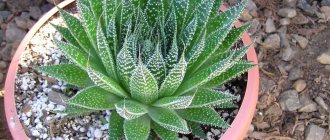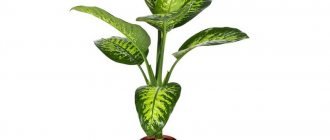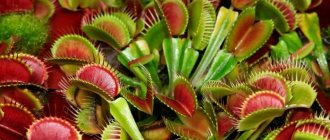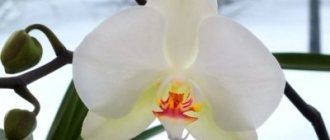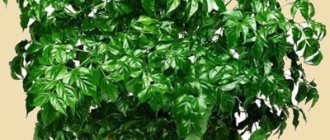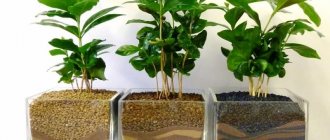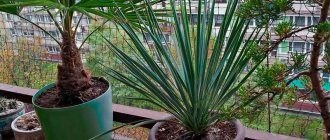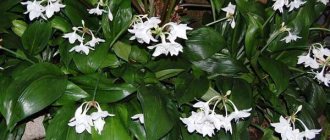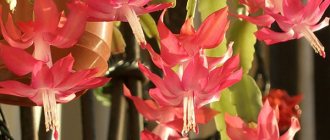Few flower growers know that there are types of coniferous plants that can be safely grown indoors. The most successful solution in this case is cypress. Although it is a winter-hardy plant, it feels great indoors all year round. In addition, it is much cheaper than its older brother cypress.
Features of the plant
Cypress trees resemble their fellow cypress trees in appearance. But if they are able to grow exclusively in the tropics and subtropics, the younger brothers will withstand any, even the most severe cold snap. These plants are widely used in the Northern Hemisphere.
Cypress trees can grow into fairly tall trees, so at home you should only grow young plants while they have soft needles. They will add 3-4 cm in height every year and will be able to stand in the room for a whole decade.
Young trees have soft and delicate needles, a pleasant bluish-gray color. As she grows older, she darkens. The bark is an attractive brown-red color, but due to the needles it is almost invisible.
By placing such an evergreen pet in your home, there will be no need to buy a Christmas tree.
Nutkan cypress
They are usually tall trees with a narrow pyramidal shape and characterized by slow growth. Over ten years of life, it grows on average to 1.1 m. The color of the bark is gray-brown. The main branches are raised and spread out. The branches are drooping, very thick, and at cross-sections they are rounded or take the shape of a tetrahedron. The needles are dense, tight and colored in a dark green color. The fruits are brown-red with a bluish coating, and do not exceed 1 cm in diameter.
- Green Arrow is small in size, capable of reaching 3.6 m by the age of ten. The crown of the plant is straight and narrow. The branches are short, drooping and often pressed along the trunk. The needles have a rich dark green tone with an admixture of blue shades.
- Jubilee is a showy plant with a straight, narrow crown formation. The main and second row branches droop, the top ones are almost in a vertical direction. Painted in bright green colors.
- Lutea is a tall, weeping species. Young shoots are colored light yellow, later turning green.
- Pendula is a popular cypress tree, reaching 1.6 m by the age of ten. The main branches are sparse, the second-order branches hang vertically, bend at the crown. The color of the needles is gray-green. They have high frost resistance.
Thuja cypress
The bark of the trees is brownish-red, and as it matures it tends to fall apart in long ribbons. The branches are flattened and thin. The color of the needles is green-gray and smells of resin when rubbed. Likes to grow in swampy areas and is highly frost-resistant.
- Andalyensis is a compact shrub with a wide pyramidal crown. The needles are awl-shaped, bristling, and partially pressed. They are painted in a bright green-bluish color, with a hint of purple added in winter. There are plants with a yellow color.
- Variegata - dense columnar or narrow pyramidal crown, branches grow chaotically. Young needles are green-blue in color, adults are painted in gray-green tones. In winter, shades of bronze, brown-red and violet-red are added.
Home care
Cypress trees are much easier to grow than cypress trees. But even here you will have to work hard to make the indoor tree look bright and healthy.
Location and lighting
To determine a place for a flowerpot with a cypress tree, you need to figure out what type of tree you purchased. Simple species can remain in the depths of the room for a long time. But varietals that have an original color are best installed as close to daylight as possible.
But both of them should be carefully protected from direct sunlight, even if this happens only in the morning or evening hours. Watch your pet's color. If the shade of the needles is muted, it means that you need to move the tub closer to the light, but only diffused.
In winter, try to move the flowerpot with cypress closer to the window, and in summer, push it deeper into the room. If the windows face north, then you can try placing a flowerpot with a bush even on the windowsill.
Also keep in mind that your pet needs regular ventilation, so place it close to the balcony doors. In the summer, the pot can be taken out to the loggia or to the open terrace. Just protect your coniferous friend from the rays of the sun, draft and rain.
Temperature
Cypress does not like heat. In the summer, it is advisable to provide it with a comfortable temperature of +18-23C. In any case, the thermometer scale should not rise above +25 degrees. In winter it is advisable to maintain +12-15C. If the air is cooler: +5-10 degrees, nothing bad will happen. But it shouldn’t be higher than +16C in the room at this time.
Watering
The soil in the container with cypress must be constantly moist. Try to water the plant regularly, as soon as the top third of the substrate dries out. There is no need to fill it too much with water either. Stick to the golden mean.
In summer, water about 2 times a week. In winter, increase the intervals between waterings. Just don’t pour in the entire portion of liquid at once. Add a little at a time, giving the moisture a chance to soak into the soil. It is advisable to use melt water for this.
Air humidity
An evergreen pet requires 50-70% indoor air humidity. If it is drier, it will negatively affect the decorativeness of the needles. So, spray the tree every evening in the warm months, and place containers with wet pebbles in close proximity. When the room is less than 18 degrees, you cannot spray cypress.
The soil
When choosing an earth mixture, make sure it is sour and coarse. Buy soil for conifers or rhododendrons. To prepare the substrate yourself, you will need the following components:
- 60% turf land;
- 30% leaf soil;
- 10% sand.
Don't forget to place a drainage layer at the bottom of the flowerpot.
Feeding and fertilizers
Cypress needs additional nutrition during active growth. It should be fed very carefully so that there is no overdose. Apply fertilizing once every two weeks, reducing the dosage by half.
Use fertilizers for conifers. As a last resort, you can purchase those for bonsai. Gently loosen the soil before adding liquid nutrients. There is no need to feed your green friend in winter. Avoid using growth stimulants so that the decorative effect does not suffer.
Transfer
The cypress tree does not like this procedure at all. Therefore, resort to it when the roots are as close as possible to the walls of the flowerpot. Young patients will need a transplant every two years. And it is advisable to disturb mature ones as little as possible.
Before purchasing a potty, measure your pet's height. The depth of the container should be three times less than the height of the cypress tree, and the width should be half the depth. The next time you are planning to replant a tree, take a flowerpot 2-3 cm wider in diameter. Choose a container with drainage holes and quite massive so that it does not tip over under the weight of the plant.
Replanting should be done by transshipment, trying to touch the roots as little as possible, and be sure to keep the earthen lump intact. After transferring the bush to a new pot and filling the gaps with fresh soil mixture, make sure that the level of the root collar is buried in the ground at the same level. Place the disturbed cypress tree in the shade and provide high humidity. Water occasionally, and feeding is allowed after a month.
If you are not going to replant at this time, remove at least the top layer of soil and replace it with fresh one. Just do it very carefully so as not to catch the roots.
Trimming
In spring, dried, yellowed or dying branches, as well as deformed shoots, should be removed to maintain the beautiful shape of the “cap”. In autumn, the branches are slightly shortened so that the tree does not grow too much.
What is a tree afraid of?
In the garden, the tree does not harbor pests, its branches are not damaged by diseases.
If the soil is very dry, the cypress will turn yellow. Branches that have lost their decorative properties will dry out over time and the stem will become bare. A dried out plant needs to be well watered and sprayed with an immune stimulant:
- Epin;
- Silk.
In the room, the cypress tree is afraid of the dry air coming from the heating radiators. In winter, you need to keep it cool in the light, protecting it from the flow of warm room air. Modern wide plastic window sills cope well with this task.
In winter, the pot needs to be moved closer to the glass. To prevent the plant from bending, from time to time it is turned around its axis by 45 degrees.
Reproduction
New cypress plants are obtained in two ways:
- from seeds;
- from cuttings.
The rooting rate in the first case is much higher.
Seeds
After stratification, the seeds can be used for six months. After treating them with a growth stimulator, plant them in a not very deep container. In order for them to sprout, bottom heating and sufficient lighting should be provided. Sprouts should be cared for carefully.
Cuttings
Cuttings can be obtained from apical or lateral shoots. The branches should just begin to become woody. The cut is made 1.5 cm below the level of transition into green tissue. You can try to tear off the branch by grabbing the heel.
After treating the tips with root, plant them in the soil mixture, covering the top with an inverted glass jar.
Other varieties
Lawson's cypress is also represented by many other varieties. Among them there are compact and tall ones. And every year at coniferous tree exhibitions you can see both old, well-proven varieties and new ones with external characteristics that are more interesting to designers. ab=danger] Important! When pruning tall bushes, never remove more than 1/3 of the green mass. This can cause the death of the plant.
We recommend reading about the red star cypress variety.
Among the most attractive:
- Green Globe is a small dark green rounded bush. Its height will be 0.3–0.5 m. Suitable for alpine slides and rock gardens;
- Ellwoods Pillar is a columnar tree 1 m high with feathery blue needles. Looks great in single compositions;
- Pembury Blue is a conical, silver-blue, tall bush. At the initial stage of development, it is characterized by an irregular shape. In 10 years, the height of the cypress tree will be 3–4 m;
- Eclipse is a tall tree-like variety, reaching a height of 3 m. It is characterized by yellow-green young needles and dark green old ones. This variety looks especially decorative in spring and early summer;
- Gnome is a spherical hemisphere slowly increasing in size with dark green lush needles. As it grows, it will stretch into a cone. And after 10 years of development, the height of the Dwarf will be only 30 cm;
- Hillieri is a medium-sized tree-like variety, growing up to 1.5 m in height with golden-green needles. The shape of the tree is cone-shaped. The shoots are numerous, so the tree is always lush.
Diseases and pests
In principle, cypress is resistant to all kinds of parasites. But malicious attacks also occur against it.
- Spider mite. If you notice a thin cobweb framed by white spots on a conifer, urgently take measures to save your pet. Otherwise, the needles will lose their brightness of color, dry out and eventually fall off.
Use special chemicals or folk remedies for treatment: a rich decoction of onions or garlic.
- Shield. Characterized by the appearance of bulges. They can be yellow, green or gray. By sucking the sap from the tree, the pest can destroy it. Try treating the needles with an infusion of potassium soap. If the situation is too advanced, you will have to resort to chemistry.
- Root rot. It can occupy the green friend due to regular overflow during watering. You may also have forgotten to drain or used the wrong soil. In this case, only replanting can help, during which the damaged parts of the roots should be removed.
Care errors
If you do not follow the regime necessary for a coniferous plant, the needles will begin to turn yellow and the tree itself will dry out. To prevent this from happening, keep an eye on:
- air humidification;
- lack of sunlight on the needles;
- low air temperature;
- not drying out of the soil mixture;
- regular feeding.
If you do everything correctly, your green friend will delight you with juicy and healthy pine needles.
Folk signs
Unfortunately, popular rumor is merciless towards the representative of the Kiparisov family. It is believed that this is a flower of death, which belongs exclusively in the cemetery. Well, if you put a flowerpot with conifers at home, it will attract the souls of the deceased into the home.
For an unmarried woman, the cypress tree seems to foretell loneliness. And if you put a flowerpot in the bedroom, it will negatively affect the mental activity of the owners.
Perhaps overly superstitious people will be imbued with such negative reviews and will not want to plant cypress in their home. But, believe me, this will not protect you from bad streaks in life, which happen to absolutely everyone without exception.
Medicinal properties
But the fact that a coniferous plant can purify the air in an apartment is a scientifically proven fact. Its presence will have a beneficial effect on the nervous and respiratory systems. The tree is capable of killing pathogenic microbes, which in our time of the coronavirus pandemic is especially important. Place a cypress tree at home, and there will be no need to use a sanitizer. After all, the green friend will disinfect the room on his own.
What you need for planting
New Year's cypress in a pot suffers from lack of soil and dry air. In the summer, a tree that has successfully overwintered in a room begins to dry out and turn yellow. It can be transplanted into open ground as soon as the ground thaws.
Any plant is better in the open air than on the windowsill. Experienced gardeners take advantage of this by transplanting capricious azaleas and roses from pots into a garden with a lump of earth, and in the fall taking them back indoors.
The cypress tree will only have to be planted once - in the fall. There will be no need to bring it into the house, as it winters well under the snow. For planting, you only need a shovel and a little bit of any fertilizer: organic, mineral or organomineral.
Kinds
Only a few types of cypress trees are suitable for home breeding. Usually in indoor conditions you can find:
- Pea-bearing. Representatives of this species are found more often than others. Their crown is cone-shaped. But closer to the top the branches diverge in different directions. The color shades can be different, and the needles are thick and soft.
- Lawson. It grows very slowly. A distinctive feature is flexible shoots. There are gray, golden and even white-green colors.
Don’t be afraid of signs and be sure to buy a cypress tree. For a whole decade, it will delight you with greenery and freshness in the room. And when it gets too big, move it outside and get a new pet at home.
Indoor cypress: brief description
- Indoor cypress, which grows in flower pots, has differences from plants growing in nature. The main and only difference is the size of the bush . The shoots of the culture are quite soft. They are covered with small leaves with scales. The leaves are shaped like an elongated diamond.
- The leaf blade is characterized by a dark green tint. In sunlight you can see a bluish glow. Small fruits form on the bushes They are ovoid in shape.
- The cones are covered with shield-like scales that hide the seeds of the plant.
- In some countries, it is believed that a cypress tree in a pot symbolizes grief. They prefer to plant it on cemetery graves.
- There is another opinion that home cypress symbolizes immortality. It is described in the holy book - the Bible, as one of the plants in the Garden of Eden.
Home tree

